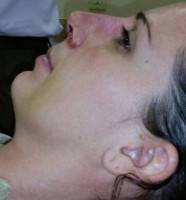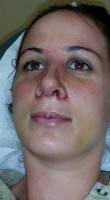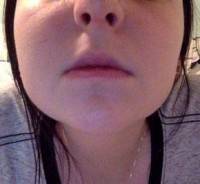Treatment for Scar Tissue after Rhinoplasty
Scar tissue can form wherever incisions are made or tissue planes separated. Depending on the approach and specific maneuvers performed during your rhinoplasty, scar tissue may form in different places.
If the scar tissue is internal, this is treatable in most patients using a combination of steroid injections (kenalog in different strengths) and massage.
Over time, as the residual swelling resolves, improvements in contour will be seen.
For scars that form at the external incisions, sometimes scar revision is indicated – though not typically within a year of the surgery. (Evan Ransom, MD, Bay Area Facial Plastic Surgeon)
Scar Tissue in Secondary Rhinoplasty
There is no optimal way to remove a scar. Secondary rhinoplasty is a complex procedure to reshape the underlying framework and close dead space.
How an individual scar heals is based 90% on the genetics of the patient. Secondary rhinoplasty surgery is a challenge in managing the post operative result. (Rod J. Rohrich, MD, Dallas Plastic Surgeon)
Rhinoplsty scar
The most common way surgeons deal with scar tissue after rhinplasty is probably by the injection of triamcinolone (Brand Name Kenalog).
This steroid is quite effective in the early healing phases for preventing scar tissue and later on for diminishing scar tissue. If by scar tissue you mean the open rhinoplasty scar is less than ideal, it may need to be adjusted in the office under local anesthesia. (Stuart H. Bentkover, MD, Boston Facial Plastic Surgeon)
Scar tissue after Rhinoplasty
Scar tissue can form internally or externally after rhinoplasty, although rare. If its just scar tissue not involving cartilage or bone you may be treated with a steroid injection.
If its involves both you may need to have surgery. Seeing the patient “in the flesh” helps to evaluate what is needed. (Carlos Wolf, MD, Miami Facial Plastic Surgeon)
Rhinoplasty scar tissue treatment
Since I feel strongly that no one should be doing open rhinoplasties, the scars that result are really unnecessary. Avoid such surgery at all costs. Scars made in the crease at the wings of the nose after reduction in width of the nostruils (an alarplasty) are almost never visible.
Scar tissue that builds up in the nasal tip (under the skin) after surgery can often be helped with steroid injections or with revision surgery. (Howard T. Bellin, MD (retired), Manhattan Plastic Surgeon)
Post rhinoplasy scar tissue can be treated with steroid injections
I think your question is relating to scar tissue under the skin rather then visible scar. If this is the case then scar tissue can be reduced with steroid injections. Your surgeon should guide you as to the need for steroid injections after rhinoplasty. (Jason B. Diamond, MD, Beverly Hills Facial Plastic Surgeon)
Rhinoplasty scars can be improved
Visible rhinoplasty scars are rare after meticulous rhinoplasty but can occur in a small percentage of patients. After waiting for a year these incisions can usually be improved with laser resurfacing. They can also be improved by revising the scars by removing them and re-suturing, but this is only required in a very severe case. (Andrew Jacono, MD, Great Neck Facial Plastic Surgeon)
Scars after rhinoplasty
Scarring is what ALL Plastic Surgeons have to fight day in and day out. It occurs both internally and with your incisions. However, scarring from rhinoplasty and other facial procedures tend to heal extremely well, almost better than anywhere else on the body.
For example, I have NEVER seen or heard of keloid scarring from rhinoplasty. While the incisions made for your nose job heal well almost all of the time, the internal scarring can be more unpredictable. Depending on technique used and your wound healing genetics, you may or may not develop excess thickened scar tissue under your skin.
This can hide all the beautiful curves from the cartilage shaping your surgeon worked so hard to create. Sometimes steroid injections (in the office) or scar debulking through a minor revision (office or trip back to the operating room) can help tremendously. Ask you doctor about what his style and preferences are with internal nose scarring and what he does to try to reduce that from occurring. (Ashkan Ghavami, MD, Beverly Hills Plastic Surgeon)
Rhinoplasty Scar Tissue
Scarring from rhinoplasty usually heals really well, but it is extremely important that you give it time. Pressure exercises may also help! (Babak Azizzadeh, MD, Beverly Hills Facial Plastic Surgeon)
Dealing with excessive scar tissue after rhinoplasty.
Usually waiting is all that is needed for scar to resolve after rhinoplasty.
Occasionally, steriod injections can be used to facilitate the process but this should be done with due deliberation.
Rarely, an operation to excise scar tissue is required but this is very uncommon in my experience. (Vincent N. Zubowicz, MD, Atlanta Plastic Surgeon)
Correcting rhinoplasty scarring
If the scars are along the bottom of the nose from narrowing procedures of the nostrils they may be corrected with a surgical revision to try to better hide the scars or laser abrasion types of procedures.
If you have an external rhinoplasty scar that has not healed well similar techniques can be used.
If the scarring is more internal and is distorting your tip, then steroid shots might be helpful or surgical debulking of the scar. (Scott Trimas, MD, Jacksonville Facial Plastic Surgeon)
What can be done for rhinoplasty scars?
There are two forms of scar tissue that can be encountered after rhinoplasty. One is at the site of skin incisions, the other is more broad based scar tissue that can cause swelling in the nasal tip, or the area immediately above the nasal tip.
If the scar is in the incision lines, then the best treatment is scar revision, by removing the old scar and suturing the incisions closed in a meticulous manner.
If the scar is in the nasal tip region, then injections of small amount of Kenalog (triamcinelone) on mentally basis, can help. (Maurice M. Khosh, MD, New York Facial Plastic Surgeon)
Nose Job Scar Tissue
Treatment of nasal scar tissue depends on the duraion, extent, and location. Lazers, steroid injections, and/or surgical intervenation may be necessary. Discuss alternatives with your surgeon or get a second opinion (Richard W. Fleming, MD, Beverly Hills Facial Plastic Surgeon)


